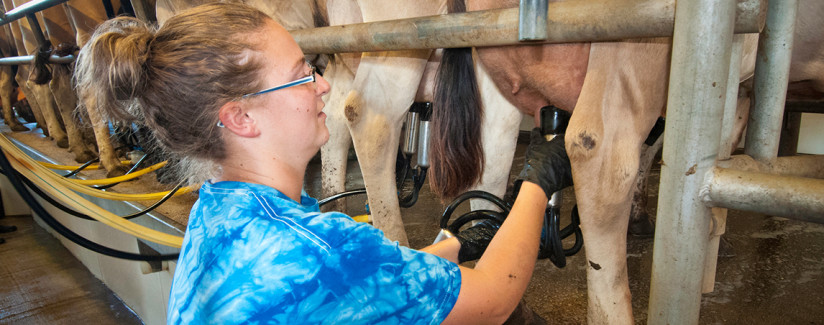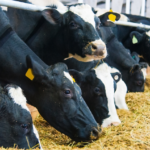
Raw Milk Q&A
Did you know that each year 1 in 6 Americans (48 million people) will become sick from a foodborne illness? The Centers for Disease Control (CDC) estimates that this may cost over $15.5 billion!
One of the culprits of these outbreaks is from the consumption of contaminated raw milk or milk that has not been pasteurized. We chatted with Best Food Facts expert Dr. Julie Garden-Robinson, PhD, RD, from North Dakota State University to find out more about raw milk.
What is raw milk?
Dr. Garden-Robinson: Raw milk is milk “straight from the animal” and has not been heat-treated to kill pathogens (disease-causing organisms).
Is it safe for me and my family to consume raw milk?
Dr. Garden-Robinson: According to the CDC, “milk and products made from raw milk (including certain cheeses, ice cream and yogurt) can pose severe health risks.” Less than three percent of Americans consume raw milk, yet many foodborne illness outbreaks are connected to the practice of consuming raw milk. From 1998 to 2011, 2,384 illnesses, 284 hospitalizations and two deaths were linked to the consumption of raw milk.
Milk that has not been pasteurized may be contaminated with a variety of microorganisms – often potential illness-causing bacteria. Some types of foodborne bacteria cause minor illnesses, while other infections can be life-threatening, especially to vulnerable populations such as young children, immune-compromised people, pregnant women and older adults.
Is raw milk legal?
Dr. Garden-Robinson: It is legal to sell raw milk in some states but illegal in others. According to the Centers for Disease Control and Prevention (CDC), foodborne illness outbreaks related to raw milk are more common in states where raw milk is legal.
How is raw milk contaminated?
Dr. Garden-Robinson: Milk can become contaminated in several ways: by cow feces coming in contact with the milk or the milking equipment, by cow diseases, by humans, by animal/insect carriers and by other means. Even dairy farms with very good safety practices can harbor illness-causing germs; there is no guarantee that one dairy farm’s raw milk is safer than another.
How can I protect my family when choosing dairy products?
Dr. Garden-Robinson: Public health experts from the CDC, Food and Drug Administration, American Academy of Pediatrics and other groups recommend consuming only pasteurized dairy products. Pasteurized milk that we buy in the refrigerated section of grocery stores is not “sterile” (free of all bacteria), so it needs to be kept cold from store to home with these tips:
- Pick up milk and other perishable foods last at the grocery store.
- Transport milk in a cooler with ice if you are driving a distance.
- Store milk in the main section of your refrigerator, not in the door where the temperature is warmer.
- Be sure your refrigerator is set at 40o F to maintain the quality and safety of dairy products.
Is raw milk more nutritious than pasteurized milk?
Dr. Garden-Robinson: The brief heating process of pasteurization does not significantly affect the nutrition of milk. For example, proponents of raw milk point to the loss of vitamin C in milk as a result of pasteurization; however, milk is not a good source of vitamin C to begin with. Further, less than 10 percent of vitamin C is lost during pasteurization.
Raw milk is marketed with a variety of health promises; however, there are no controlled scientific research studies that have shown raw milk to be a “cure-all” for conditions like lactose intolerance, asthma and allergies. The risks of drinking raw milk outweigh any possible benefits.
We’ve heard that the good bacteria in raw milk is beneficial for the GI tract, microbiome and overall health – is this true?
Dr. Garden-Robinson: Although online testimonials and marketing materials may claim these health benefits, well-controlled scientific studies have not shown this to be true. If you are interested in foods that promote gut health, consider adding some probiotic foods to your diet. For example, opt for pasteurized yogurt with added “live and active cultures.” Other probiotic foods include kefir, sour cream, buttermilk and sauerkraut. Research linking probiotics to health benefits is ongoing.
What is pasteurization and why is it important?
Dr. Garden-Robinson: Pasteurization has been used for about 100 years to kill disease-causing organisms in milk and to extend shelf life. During pasteurization, milk is treated with specific temperature-time combinations such as these: 1) 145 degrees Fahrenheit for 30 minutes; 2) 161 degrees Fahrenheit for 15 seconds; or 3) 280 degrees Fahrenheit for 2 seconds.
What is ultra-pasteurization?
Dr. Garden-Robinson: Ultra-high-temperature (UHT) pasteurized milk has been processed with the temperature-time combination of 280 degrees Fahrenheit for 2 seconds, which sterilizes the milk and increases the shelf life. With the combination of special packaging techniques and the heating process, UHT milk can be stored safely without refrigeration for many months.
BOTTOM LINE: For the sake of safety, choose pasteurized milk and dairy products as an excellent source of a variety of nutrients.
More Information about raw milk:
- American Academy of Pediatrics: http://pediatrics.aappublications.org/content/early/2013/12/10/peds.2013-3502
- Centers for Disease Control and Prevention: www.cdc.gov/foodsafety/rawmilk/raw-milk-index.html
- Food and Drug Administration: www.fda.gov/Food/ucm293042.htm
“20130911-OC-RBN-3959” by USDA is licensed under CC BY 2.0

























